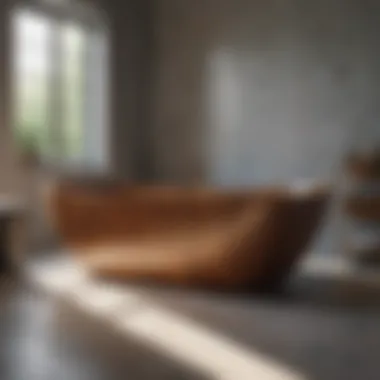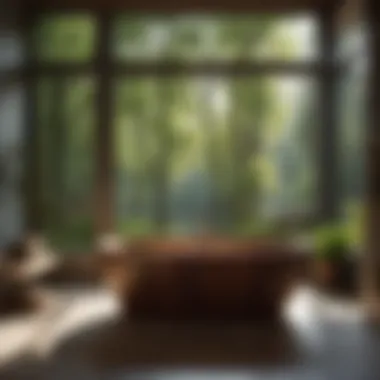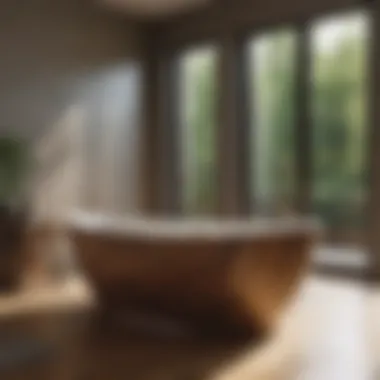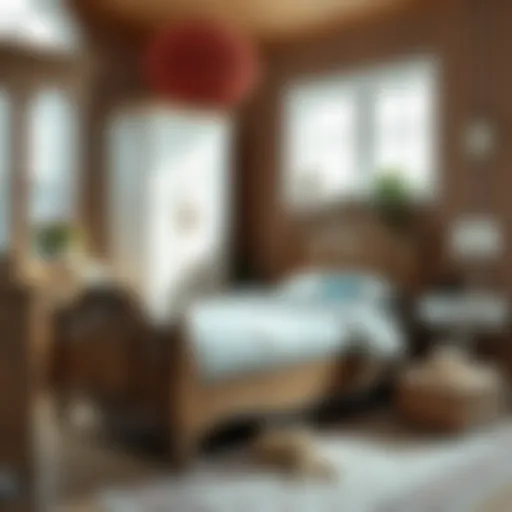Freestanding Wood Bathtubs: Design and Benefits


Intro
Freestanding wood bathtubs have surged in popularity, carving their niche in modern bathroom designs. They stand out not just for their elegance but also for the rich aesthetic they bring to bath spaces. As homeowners seek ways to elevate their bathing experience, incorporating a decorative yet functional bathtub becomes paramount. This guide intends to dissect various aspects of these wooden wonders, showcasing their appeal, practical dimensions, and what one needs to consider before making a choice.
Imagine soaking in a tub crafted from natural materials, surrounded by the gentle warmth of wood, all while indulging in a retreat from the world. The market offers numerous designs, from rustic to contemporary styles, making it essential for buyers to navigate their options with insight.
As we embark on this exploration, it's crucial to highlight the key elements that define freestanding wood bathtubs. We'll delve into current design inspirations that capture contemporary trends and how these designs marry with color palettes that reflect personal taste. Furthermore, we'll shine a light on functional elements that cater to the practical side of home life, ensuring that your investment is both visually appealing and useful.
Design Inspirations
The world of home design is ever-evolving, and freestanding wood bathtubs are splendid examples of this evolution, blending seamlessly into various bathroom aesthetics.
Latest Trends in Bath and Bedroom Design
In today’s design landscape, the integration of natural materials is a prevailing trend. Freestanding wood bathtubs embody this philosophy, transforming the bathroom into a sanctuary.
- Minimalism: Clean lines and uncluttered spaces dominate, allowing wooden bathtubs to take center stage.
- Biophilic Design: Incorporating natural elements promotes wellness. A wooden tub not only serves as a functional piece but also connects indoor spaces with the outdoors.
- Vintage Revival: Rustic wood finishes paired with vintage plumbing fixtures evoke nostalgia while maintaining a modern touch.
The diversity in designs allows homeowners to convey their personality. For example, one might opt for a reclaimed wood tub that tells a story alongside contemporary finishes for juxtaposition.
Color Palettes and Themes
Choosing the right colors to surround a freestanding wood bathtub is key to creating an inviting atmosphere.
- Warm Tones: Browns and creams can enhance the wood’s natural hue, providing a cozy vibe.
- Cool Contrasts: Grays or soft blues can create a refreshing contrast, emphasizing the wood and elevating the overall bathroom design.
- Natural Greens: Plants paired with wooden features infuse life into the space, making it feel like a personal oasis.
The right combination of color and texture can make the tub a striking focal point, drawing attention without overwhelming the senses.
"The beauty of a freestanding wood bathtub isn't just in its visual appeal; it's also about creating a space where one feels at peace after a long day."
By thoughtfully considering these design inspirations, homeowners can craft a bathroom that not only meets functional needs but also stands as an expression of their style. The narrative of a home is enhanced by choices like these, paving the way for surrounds that resonate with individual lifestyles.
Prelims to Freestanding Wood Bathtubs
Freestanding wood bathtubs have been captivating interior designers and homeowners alike with their unique charm and practicality. In this article, we will explore the enchanting world of these luxurious fixtures and why they've become more than just a trend but a statement piece in modern bathroom design. Bathroom spaces are no longer just functional areas; they are personal sanctuaries where individuals seek relaxation and rejuvenation. Hence, choosing a bathtub isn't merely about utility, it's about creating an experience that reflects one’s style and personality.
Historical Context
The concept of wooden bathtubs dates back to ancient civilizations where bathing was an important ritual, but it wasn't until the Victorian era that bathtubs became more commonplace in homes. During this time, materials like cast iron and ceramic dominated the market. The resurgence of wooden tubs in contemporary design may seem like a nod to the past, but it also reflects our growing appreciation for natural materials. As environmental awareness has grown, so has the demand for sustainable products. Wood, with its organic beauty and customizability, stands out as a material that merges history with modernity.
The Japanese onsens, with their natural wooden tubs, have long been a source of inspiration. The harmonious blend of nature and utility creates a bathing experience steeped in tradition. When you step into a wooden tub today, you're also stepping into a rich narrative that ties you back to these traditions.
Current Trends in Bathroom Design
Today's bathrooms are evolving into spaces that embody both luxury and comfort. Freestanding wood bathtubs are becoming central fixtures in this design shift. Homeowners are increasingly seeking ways to transform their bathrooms into an oasis, and wood bathtubs add a layer of warmth often lacking in traditional bathroom materials such as porcelain or acrylic.
Some significant trends driving the popularity of these bathtubs include:
- Biophilic Design: There's a strong movement toward incorporating nature into homes. Wooden bathtubs echo this desire, creating a tactile connection with the outdoors.
- Customization: Many manufacturers now offer custom options in size, shape, and wood type, allowing homeowners to tailor their bathtubs to fit personal aesthetics.
- Sustainability: With climate change awareness rising, using responsibly sourced wood plays into a larger framework of sustainable living that many consumers are embracing.
Material Choices for Wood Bathtubs
Choosing the right material for a wood bathtub is as crucial as selecting a favorite book. It shapes not just the look and feel of the space but also the performance and durability of the bathtub itself. In an era where aesthetics marry functionality, wood emerges as a popular, though sometimes misunderstood, option. Homeowners are increasingly drawn to freestanding wood bathtubs due to their warm, inviting atmosphere and distinctive character. This section will break down the different types of wood commonly used, along with important considerations regarding durability.
Types of Wood Used
Teak
Teak is often hailed as the king of bathtub wood. Renowned for its water resistance, this tropical hardwood naturally contains oils that repel moisture and prevent rotting. One key characteristic of teak is its beautiful grain pattern, which can add richness to any bathroom environment. This aesthetic appeal makes it a favorite choice among designers looking to create a luxurious ambiance.
However, there are some downsides. The price point of teak can be steep, making it a considerable investment. Additionally, sourcing teak responsibly can be a concern, as not all teak is harvested sustainably. Therefore, it is essential to seek out certified sources if you choose this magnificent wood.
Red Cedar


Red cedar is another wood that’s making waves in the world of bathtubs. Known for its distinct, aromatic scent, it provides an almost therapeutic experience while bathing. One of the best features of red cedar is its resistance to splitting and warping, which is a real plus for wood bathtubs. Its light weight also means it’s easier to handle during installation. However, red cedar may not be as dense as other woods like oak or teak, which could potentially affect its performance over time, especially in humid environments. Homeowners should consider whether they prefer the aromatic experience of red cedar over the robustness of other options.
Oak
Last but not least is oak, a classic choice that has stood the test of time. Versatile and sturdy, oak bathtubs can fit both modern and traditional settings. One of the significant advantages of oak is its incredible durability; it can withstand the rigors of daily use. Furthermore, its natural strength means that it can be treated to enhance its water resistance, broadening its usage in moist environments. On the downside, oak can be heavier than some other wood options, which may raise concerns during installation or future relocations. It also doesn’t have the same natural resistance to decay as teak, which means regular maintenance is essential to keep it in pristine condition.
Durability Considerations
When considering a wood bathtub, durability should be a primary concern. Not all types of wood are created equal, with each species having its own set of strengths and weaknesses. For longevity, it’s critical to think about
- Regular maintenance needs
- Environmental factors such as humidity and temperature changes
- Whether the wood can handle constant exposure to water
Ultimately, a freestanding wood bathtub can be a stunning focal point in your home if you choose the right materials that suit your lifestyle and aesthetic preferences.
Design Options and Styles
The design options and styles available for freestanding wood bathtubs play a crucial role in shaping their appeal and functionality within modern homes. As more homeowners seek to create personalized sanctuaries, the choice of design reflects not just aesthetic preferences but also the individual’s lifestyle and values. Opting for the right style can significantly elevate the ambiance of a bathroom, turning it from a mere utility space into a true haven. Moreover, these tubs offer a unique chance to express personal taste, creating a focal point that enhances overall home decor.
Modern Aesthetic
In recent years, the modern aesthetic has garnered a lot of attention in bath designs. Freestanding wood bathtubs within this style often embrace clean lines and minimalist elements. They integrate seamlessly into contemporary spaces that prioritize simplicity and elegance.
- Sleek Lines: These tubs often feature angular shapes and smooth finishes, merging with chic bathroom accessories, such as sleek fixtures and neutral color palettes.
- Natural Tones: The use of wood tends to bring warmth and a touch of nature, striking a balance between contemporary design and organic materials.
- Material Innovation: Some modern designs utilize engineered woods or modified timbers that enhance durability, lending themselves well to innovative interiors.
For a striking effect, one might consider integrating a modern wood bathtub with floor-to-ceiling windows that allow for abundant natural light, thus highlighting the natural grain of the wood while merging the indoor environment with the outside world.
Rustic Appeal
On the flip side, the rustic appeal focuses on rugged charm and character. These freestanding wood bathtubs often resonate with those who wish to create a comforting, homey atmosphere reminiscent of a cozy cabin or a countryside retreat.
- Nature-Infused Design: The raw and unfinished look is often celebrated, showcasing the beauty of imperfections in the wood grain. A connection to nature is paramount here, where every bathtub tells its own story.
- Warm Color Palettes: Earthy tones and distressed finishes might be favored, enhancing the traditional feel. Integrating accessories like wrought-iron fixtures or vintage wooden cabinets can further emphasize the rustic theme.
- Environmentally-Focused: Rustic wood baths often come from sustainably sourced timber, appealing to environmentally conscious homeowners.
Picture a wood bathtub nestled by a stone wall, surrounded by planters of fragrant herbs, creating a true escape into nature. It's an inviting setting for anyone wanting to unwind away from the rush of modern life.
Customization Possibilities
One of the most exhilarating aspects of freestanding wood bathtubs is the sheer scope for customization, giving homeowners the ability to tailor their bathtubs to specific tastes or needs.
- Size and Shape Variations: From compact designs perfect for smaller bathrooms to expansive models that accommodate two, the options are varied.
- Finishes and Treatments: Homeowners can choose from different stains and finishes, allowing for a range of looks, from glossy modern to matte rustic.
- Integrative Features: Additional features like built-in shelves or integrated lighting can be incorporated for both functionality and enhanced ambiance.
- Personal Touches: Emblazoning the bathtub with personalized engravings could be the cherry on top. This ability to make the fixture unique buries the generic, offering something that looks like it was made just for them.
Customizing a bathtub isn’t just about looks; it’s about curating an experience—turning a bathroom into a unique retreat where personal style can truly shine.
"Choosing the right design options for your freestanding wood bathtub can transform your bathroom into a personalized oasis, enhancing both aesthetic appeal and overall relaxation." - Interior Design Expert
Overall, the design options and styles available for freestanding wood bathtubs are as varied as the individuals who choose them. Homeowners are encouraged to reflect on their personal style and needs before making a choice that resonates with their vision for a tranquil bathing experience.
Benefits of Choosing a Wood Bathtub
Freestanding wood bathtubs are more than just a place to wash away the day's fatigue; they embody a blend of sophistication and functionality that can elevate the ambience of any bathing space. This section delves into the key advantages of selecting wood bathtubs, pinpointing significant elements such as aesthetic appeal, environmental impact, and thermal qualities.
Aesthetic Value
One of the most striking traits of wood bathtubs is their aesthetic charm. They effortlessly transform an ordinary bathroom into a lush retreat reminiscent of a high-end spa. Their warm tones, unique grain patterns, and organic shapes create an inviting atmosphere that synthetic materials simply cannot replicate.
- Timeless Appeal: Wood carries a weight of tradition and elegance; using it in intimate spaces speaks volumes about one's taste. A tub crafted from rich teak or warm red cedar may serve as a stunning centerpiece.
- Customization: Wood’s inherent versatility allows for endless design possibilities. Homeowners can choose from various finishes, shapes, and sizes to perfectly fit their dream bathroom. Additionally, custom engraving or accents can be added to personalize the piece.
- Integration with Nature: The natural look of wood promotes a feeling of connection with the outdoors, creating a soothing retreat away from the hustle and bustle of everyday life. A wooden tub aligns beautifully with themes of greenery or earth-tones, maintaining a seamless flow throughout the space.
Environmental Considerations
Choosing a wood bathtub can also align with a commitment to environmental responsibility. Unlike plastic or metal options, many wood bathtubs are sourced from sustainable forests, thereby reducing the carbon footprint.
- Sustainable Sourcing: Many manufacturers are now making it a priority to use wood from certified sustainable forests, ensuring minimal impact on the ecosystem. This eco-conscious approach pairs luxury with responsibility.
- Biodegradability: At the end of its life cycle, a wood bathtub can return to nature without leaving harmful residues. In contrast, traditional materials like fiberglass often end up in landfills, where they can take years to decompose.
- Low-Chemical Emissions: Wood has a low level of volatile organic compounds (VOCs), which are harmful to indoor air quality. By opting for a wooden bathtub, homeowners may avoid the chemical off-gassing common in synthetic alternatives.


Thermal Properties
Another understated benefit of wood bathtubs lies in their thermal properties, which can dramatically enhance the bathing experience.
- Heat Retention: Wood is naturally insulating, which means it retains heat for longer periods, providing a cozy soak without the constant need to reheat water. This warmth translates into a more luxurious experience as you luxuriate in your bath.
- Comfortable Touch: Unlike cold ceramic or metal bathtubs, a wooden surface feels gentle against the skin. This tactile warmth enhances the comfort level, making every dip feel like a warm embrace.
- Temperature Control: Wood can provide a far more stable temperature than other materials, helping keep the water at a comfortable level longer. This feature is particularly beneficial in colder climates where the bathwater can cool quickly.
"Investing in a wood bathtub is not just about aesthetics, it's also a step towards sustainability and enhanced comfort."
In summary, the benefits of choosing a wood bathtub go beyond mere appearance. They reflect a commitment to craftsmanship, environmental stewardship, and an elevated bathing experience. Such considerations make wood bathtubs a compelling choice for those looking to enhance their homes.
Installation Guidelines
The installation of freestanding wood bathtubs goes beyond merely placing the tub in a bathroom. It combines art, precision, and a bit of elbow grease. This section discusses the nuances of getting your tub from a mere concept to a fully operational centerpiece in your home. By focusing on preparation, plumbing, and choices between hiring a professional or going the DIY route, you can navigate this pivotal phase of your bathroom renovation with confidence.
Preparation and Planning
When it comes to installation, preparation is half the battle. Before even lifting your bathtub into place, you'll want to assess your bathroom layout. It’s vital to consider not just where the tub will sit but also its relationship with other elements in the room such as faucets, vanities, and toilet placements.
- Measure Twice, Cut Once: Ensure you know the dimensions of the bathtub. Diagonal corners, door frames, and window placements can significantly affect your plans. Take accurate measurements and think about how you’ll transport the bathtub into its new home.
- Flooring Assessment: Not all floorings are created equal. Ensure your floor can handle the weight of the tub, plus the water and bathers. If your floors sag or creak, you might need to consider reinforcement.
- Ventilation Matters: Bathrooms can get steamy, and having good airflow minimizes the risk of mold and damage to wooden bathtubs. Think about the windows and exhaust fans.
Plumbing Considerations
Once the planning phase is out of the way, the next step is plumbing. It is often the backbone of a successful installation. Freestanding wood bathtubs generally have specific plumbing requirements that differ from traditional built-in options.
- Inlet and Outlet: Make certain your plumbing layout accommodates both the hot and cold water inlets as well as proper drainage. Adjustments to existing plumbing may be necessary, depending on where your bathtub will sit.
- Height Adjustments: Since these tubs sit off the floor, ensure that your plumbing workers accommodate for this height when installing taps.
- Water Supply Lines: Installing the water supply lines can sometimes be the trickiest part. Depending on where your existing plumbing lies, you may have to work within certain constraints.
Professional vs. DIY Installation
The choice between hiring contractors for installation or taking on the project yourself is monumental. Understandably, it can be tempting to save a few bucks and tackle the job alone, but consider the following:
- Pros of Hiring a Pro:
- Cons of Hiring:
- Expertise: Professionals know the ins and outs of installations and can help avoid common pitfalls.
- Time-Saving: What may take an amateur days can often be done in a few hours by pros.
- Warranty and Safety: Often, professional installations come with warranties, giving you peace of mind.
- Cost: Hiring can be significantly more expensive, reducing your overall budget for your renovation.
- Less Personal Touch: A professional might not capture the exact vision you have for your setup.
If you’re confident in your abilities, go ahead and take on the project! But if you have any lingering doubts, don’t hesitate to reach out for help.
Engaging in a DIY project can be a great way to connect with your home while also saving some cash, just be vigilant about the nuances of bathroom plumbing to avoid costly mistakes.
Maintenance and Care for Wood Bathtubs
Keeping your freestanding wood bathtub in prime condition is not just about aesthetics; it's crucial for ensuring longevity and performance. Wood, by its nature, needs a bit more TLC compared to other materials like enamel or acrylic. This section delves into the industrious upkeep needed to maintain these beautiful fixtures, shedding light on why it's essential and offering practical tips and tricks to keep them looking their best.
Cleaning Guidelines
Regular cleaning is non-negotiable when it comes to wood bathtubs. Unlike synthetic materials, wood can absorb moisture and harbor bacteria if not cared for properly. Here's how to keep your bathtub sparkling clean:
- Use mild soap: Opt for gentle, biodegradable soaps. Harsh detergents can strip the finish and damage the wood.
- Soft cloths only: Avoid abrasive scrubbers. A soft microfiber cloth does wonders and won't scratch the surface.
- Dry after use: After bathing, always wipe down the bathtub to remove water spots and prevent mold growth.
- Monthly deep clean: Mix equal parts of white vinegar and water for a natural cleaner. This solution not only cleans but can also help to deodorize.
"A little care goes a long way in extending the life of your tub. - All it takes is a moment each day to keep it stunning!"
Preventing Damage
Wood is a living material, and it reacts to its environment. Therefore, prevention is key to maintaining your wood bathtub. Here are some strategies:
- Avoid extreme heat: Direct sunlight or hot surroundings can warp wood. If your bathroom has large windows, consider using window treatments.
- Control humidity: Keep the bathroom well-ventilated. A dehumidifier can help reduce moisture levels that may affect the wood.
- Use bath mats: Placing mats around the bathtub can help prevent water from splashing onto the wood surface. They absorb excess moisture that could lead to swelling or rotting.
- Regular inspections: Keep an eye out for any signs of wear or damage. Early detection of cracks or splits can save you from bigger repair costs down the line.
Incorporating these maintenance and care practices not only enhances the appearance of your wood bathtub but also ensures it remains a luxurious centerpiece in your home. With diligent effort, you can enjoy your freestanding wood bathtub for many years, turning bathing into a delightful experience.
Freestanding Wood Bathtubs in Different Settings


Freestanding wood bathtubs are not just functional pieces in bathrooms; they can elevate the entire ambience, creating a sanctuary that reflects personal taste and lifestyle. This aspect is particularly relevant to homeowners and housewives that want to craft their bathing experience into something special. The setting in which these bathtubs are placed significantly impacts their overall effect, transforming a simple wash into a lavish ritual.
Luxury Bathrooms
In luxury bathrooms, the integration of freestanding wood bathtubs brings sophistication. These bathtubs often serve as the focal point, drawing the eye immediately upon entry. The rich textures and warm tones of wood add depth to the sleek surfaces commonly found in high-end spaces. Having a wooden bathtub can create an inviting contrast against marble or glass tiles, enhancing both warmth and elegance.
Moreover, luxury bathrooms often focus on creating an experience of retreat. The addition of a freestanding wood bathtub contributes to this atmosphere by allowing for more spacious designs. Imagine a lavish space where the bathtub sits proud and tall, perhaps even fitted with elegant fixtures for indulgent bubble baths. Homeowners can also design surrounding elements such as candles, plants, or stylish shelves to finish the look.
Beyond aesthetics, luxury settings come with additional considerations. These bathtubs require specialized maintenance to retain their beauty and utility. Homeowners should invest in high-quality products specifically meant for wood care to ensure longevity. Understanding the unique characteristics of each wood type used in the bathtub's construction—like the moisture resistance of teak—further enhances the overall experience, making luxury practical as well.
Spa-Like Environments
Creating a spa-like atmosphere in one’s home has become increasingly desirable, and freestanding wood bathtubs fit perfectly into this vision. A wood tub evokes a connection to nature, instantly promoting relaxation and calmness. Imagine soaking in a beautifully crafted tub while surrounded by soft lighting, aromatherapy scents, and gentle soundscapes—this could be an everyday indulgence for many homeowners.
In a spa setting, the visual aesthetics of wood can enhance the sense of tranquility. Varieties like red cedar exude a natural fragrance that complements the serene environment. Incorporating water features, such as small fountains or decorative stones, may enrich the sensorial experience further, seamlessly connecting the bathtub to the broader design theme.
Considering layout is also crucial in these settings. A freestanding wood bathtub encourages open space, allowing light to flow in, and making the bathroom feel less confining. Homeowners might choose to position their tub near windows to let in natural light or create a private nook away from the rest of the house, perfect for unwinding after a long day.
Incorporating a freestanding wood bathtub in your home not only modifies the bathroom's appearance but transforms the bathing ritual into an experience of luxury and well-being.
Overall, whether in a luxury bathroom setting or a tranquil spa-like environment, freestanding wood bathtubs offer a wealth of benefits. They are more than just a place to wash; they represent a lifestyle choice promoting relaxation, beauty, and connection to one's surroundings.
Cost Considerations
Understanding the costs associated with freestanding wood bathtubs is crucial for homeowners eyeing this elegant addition to their bath space. The investment can vary widely based on multiple factors, from the type of wood and craftsmanship to installation services. By weighing both initial and long-term expenses, you can better appreciate the true financial implications of choosing a wood bathtub.
Initial Investment
The initial investment for a freestanding wood bathtub can put a dent in your wallet, but the charm it brings to a bathroom makes it often worth every penny. Prices commonly range from a few thousand to upwards of ten thousand dollars, heavily influenced by factors such as the type of wood, size, style, and brand reputation.
- Type of wood: High-quality woods like teak and red cedar not only have a striking appearance but also come with a steeper price tag. Cheaper alternatives may save you some bucks, but they often fall short in durability and aesthetics.
- Design complexity: The more intricate the design, the more you are likely to pay. Unique features or customized designs simply add to the cost, reflecting the craftsmanship involved.
- Brand influence: Just like a designer handbag, some brands command higher prices due to their reputation for quality and luxury. Aligning your choice with your budget is key here.
It is also important to pre-plan your budget to avoid any financial surprises. Doing thorough research and shopping around can help you find a unit that fits your style without breaking the bank.
Long-Term Value
When discussing the long-term value of freestanding wood bathtubs, one must consider not just the material but also the overall impact it has on a home. While the upfront cost can be intimidating, the potential for increased property value and the unique appeal these bathtubs offer is compelling.
- Increased home value: A well-crafted wood bathtub can elevate your home’s marketability. Potential buyers often see these as luxury features, and they might be willing to pay a premium for them. This can be especially true in homes aimed at resale in upscale markets.
- Longevity and aesthetic appeal: Unlike many bathroom fixtures that wear out over time, a quality wood bathtub can last for decades with proper maintenance. The natural beauty that wood brings can also evolve, getting better with age, which means you won't just have a useful item – you'll own a work of art as well.
- Energy efficiency: Wood has natural insulating properties, which can reduce energy bills associated with heating water. This benefit can add up over years, offering a tangible return on investment.
"Investing in a wooden bathtub isn't just about enhancing a bathroom; it’s about making a statement that blends artistry and functionality."
With all these aspects in mind, it's evident that understanding the cost considerations of freestanding wood bathtubs provides homeowners not only insight into their financial obligations but also enables them to discover the value these bathtubs can add to their homes. Achieving a balance between cost and benefit can transform your bathing experience into something truly special.
Final Thoughts
When it comes to selecting a freestanding wood bathtub, there are various factors to contemplate, making this junction critical in the decision-making process. This section emphasizes several important elements, laying the groundwork for potential owners to be equipped with knowledge that not only informs but also inspires.
Making an Informed Decision
Choosing a freestanding wood bathtub signifies more than just an aesthetic upgrade; it embodies a lifestyle choice. An informed decision requires an understanding of the distinct benefits and considerations surrounding these unique fixtures. It's essential to evaluate your personal preferences against practical realities.
Consider aspects such as:
- Budget: From the initial investment to maintenance costs, knowing your financial capacity is key. Wood bathtubs can range significantly in price, influenced by the type of wood and design complexity.
- Space and Design: Evaluate your bathroom layout. A spacious environment can accentuate a wood bathtub's beauty, while cramped spaces might detract from its charm. Do you envision a modern, sleek look or a more rustic vibe? Visualizing this helps to narrow your choices.
- Usage and Maintenance: Will this tub primarily serve as a functional bathing area, or is it more for display? The level of care required for various woods differs. Some woods like teak require less upkeep compared to others. Determine what aligns with your lifestyle.
Educating oneself on these factors can help in making a good decision that fits well with both personal desires and functional needs.
Embracing Personal Style
A freestanding wood bathtub can truly become the centerpiece of a bathroom, reflecting your personality and taste. To embrace your personal style means delving into the diverse world of design options and aesthetics that wood bathtubs can offer.
Think about how you can express your individuality:
- Color and Finish: Consider the wood's natural hue and the possibility of custom finishes. A rich mahogany might evoke warmth, while lighter woods add a sense of airiness.
- Shape and Size: From sculptural forms to traditional silhouettes, the shape of the bathtub plays a crucial role in the overall bathroom vibe. Choose something that resonates with your personal aesthetic.
- Surrounding Decor: Complement your wood bathtub with thoughtful decor choices. Natural elements, like stone or plants, enhance the wooden aesthetic. It creates a cohesive look that feels harmonious.
Ultimately, customizing your wood bathtub not only elevates the space but also infuses it with a sense of personal touch. Creating a sanctuary tailored to your tastes is both rewarding and soothing, offering a retreat from the chaos of daily life.















